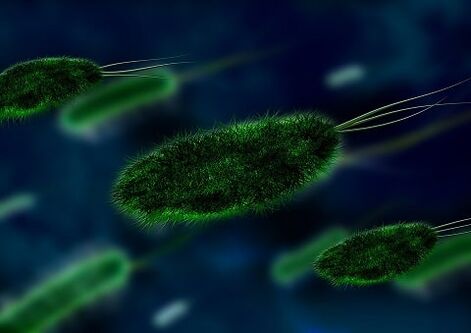To understand nutrition for gastritis, you first need to understand its causes. The most common cause is a bacterium - Helicobacter pylori. Due to its structure, this microbe penetrates the protective barriers of the stomach, attaches itself to the epithelial cells and damages them with the development of chronic gastritis.
Chronic gastritis is one of the most common stomach diseases. It accounts for 85% of all injuries to this organ.

There are gastritis and allergies with food allergy to dairy products, eggs, chocolate, etc.
The gastrointestinal tract is a single indissoluble system and, if one link in that chain is damaged, there will be a violation in all others. Therefore, chronic gastritis is often associated with a malfunction of the liver, intestines and pancreas.
But the nutritional factor in the occurrence of gastritis, today, does not play such an important role. However, gastritis can be caused by:
- Violation of eating rhythm (irregular and hurried meals with insufficient chewing of food);
- Eating poor quality food;
- Abuse of very spicy foods (pepper, adjika, mustard, vinegar, etc. ), especially if these foods are unusual for you;
- Marinades, smoked meats, heavily fried dishes in frequent use;
- Abuse of very hot or very cold foods;
- Alcohol abuse.
Of course, all of these factors must be taken into account in nutrition for gastritis.
Iron deficiency can also cause gastritis. You can read more about nutrition for anemia in the article at the link.
Nutrition for gastritis in various ways

Nutrition for gastritis will depend on its shape. There are gastrites with high acidity and gastrites with low acidity.
The acidity of the stomach is determined by the amount of hydrochloric acid produced. If it is too much, it increases the acidity, it decreases little. Acidity is measured using a pH meter during fibrogastroduodenoscopy. But there is a small nuance here: the research is carried out in 20-30 minutes, and hydrochloric acid is produced in our country constantly. And the introduction of a tube in the stomach is a stimulating factor for the production of hydrochloric acid. To more accurately assess gastritis with increased or decreased acidity, it is necessary to monitor hydrochloric acid production daily.
| products | Use |
| gastritis butter | 5-10g per day, if normally tolerated by the patient, then you can |
| almond milk for gastritis | also watch individually |
| gastritis milk | can be average |
| coconut milk, oil for gastritis | individually |
| gastritis bread | possible, undesirable wheat |
| salmon for gastritis | limited, 40-60g per day |
| bulgur with gastritis | undesirable wheat |
| avocado for gastritis | limited, 30g per day |
| vegetables for gastritis | individually |
| mackerel for gastritis | limited, 40-60g per day |
| trout with gastritis | limited, 40-60g per day |
Today, food for gastritis must be personalized, taking into account the individual tolerance of the products. Wheat and fats are limited. And that is all. We also limit coffee, alcohol, nicotine. The person should avoid foods that cause pain and discomfort individually.
There are general nutrition principles for gastritis:
- Cooking methods - ideally boiling, stewing, cooking on a mango without the formation of a very deep crust. You need to cook in a nonstick pan or with nonstick paper. Fats in the form of butter or coconut oil should be added to ready meals.
- Foods should also be mechanically delicate - cook soups in puree or chopped foods.
- If you want to study in more detail the question of preparing diets for various diseases, you can also come to nutritionist courses without medical training.

Nutrition for gastritis with high acidity:
- Exclude from the diet foods that stimulate the production of hydrochloric acid and irritate the mucous membrane - strong broths (mushrooms, meat, fish), smoked meats, fried foods, spices, pickles, pickles, mushrooms, coffee, strong tea, alcoholic drinks, watercarbonated, bakery products with fresh butter.
- Products recommended for gastritis with high acidity: Cooked meat and fish, boiled eggs, pasta, cereals, stale white bread, milk soups. Vegetables are cooked or boiled in mashed potatoes and steamed souffles. Kissels, mousses, jams, baked apples, cocoa with milk, weak tea are also allowed.
Nutrition for gastritis with low acidity:
- Recommended foods: soup with low fat broth, meat with low fat content (even fried, but without a hard crust), fish with low fat content, all fresh and not very acidic fermented dairy products, stale bread of different typesvarieties, crackers, vegetables and fruits - both cooked and in cheese, milk, eggs - raw and omelets, various well-cooked cereals, fruit and vegetable juices, butter, tea, coffee, cocoa.
To make it clearer, I will give a list of foods allowed for gastritis in the table:
What is acceptable in the diet for gastritis with high acidity?
| Fruits: |
| Baked apples / pears, bananas, oranges, persimmons, kiwi, avocado |
| Vegetable: |
| Chinese cabbage, carrot, beet, zucchini, eggplant, pumpkin, cucumber, pepper, celery, tomato, potato |
| Cereals: |
| Wild rice, buckwheat, whole oats, quinoa, millet; flour - almond, rice, amaranth, buckwheat, coconut |
| Me at: |
| Rabbit, turkey, chicken, quail, veal |
| A fish: |
| Low in fat (dorada, pelengas, pike, hake, etc. ) and fat (salmon, salmon, sea bass, trout, sea bass, etc. ) |
| Seafood |
| Bread, noodles: |
| Rice or buckwheat bread, gluten-free bread, rice or buckwheat noodles, stale white bread, white bread croutons |
| Oils, nuts, seeds: |
| Olive oils, flaxseed, coconut, avocado, sesame, pumpkin seeds, sunflower seeds |
| Milk derivatives: |
| Hard cheeses, butter, almond milk, rice milk, coconut milk |
| Eggs: |
| Chicken, quail - cooked, omelet |
What is acceptable in the diet for gastritis with low acidity?
| Fruits: |
| Various raw and roasted fruits |
| Vegetable: |
| White cabbage and other types of cabbage, carrot, beet, zucchini, eggplant, pumpkin, cucumber, pepper, celery, tomato, potato, radish, daikon, green leaves, onion, parsley, dill |
| Cereals: |
| Wild rice, buckwheat, whole oats, quinoa, millet; |
| flour - almond, rice, amaranth, buckwheat, coconut |
| Me at: |
| Rabbit, turkey, chicken, quail, veal, meat |
| A fish: |
| Low fat (dorada, pelengas, pike, hake, etc. ) and fat (salmon, salmon, sea bass, trout, sea bass, mackerel, etc. ) |
| Seafood |
| Bread, noodles: |
| Rice or buckwheat bread, gluten-free bread, rice or buckwheat noodles, various types of stale bread |
| Oils, nuts, seeds: |
| Olive, flaxseed, coconut, avocado oil, sesame, pumpkin |
| Nuts, almonds, cedar, pistachio, pecan, Brazilian; pumpkin seeds, sunflower seeds |
| Milk derivatives: |
| Milk, cottage cheese in the form of casseroles / cheesecakes, kefir, yogurt, fermented milk, yogurt, hard cheeses, butter, almond milk, rice milk, coconut milk |
| Eggs: |
| Chicken, quail |
What is the diet for gastritis?
- Meals 5 times a day. Three main meals and two snacks.
- Food preparation methods - boiling, stewing, steaming, roasting on mango, sous vide. Do not bake until golden brown. Fry in a nonstick skillet or parchment.
- Cooking over the fire and grilling are not healthy.
- Drink water 30 minutes before meals or 40 minutes after.
- Nuts (except pine nuts and pistachios) should be immersed in water for at least three hours before use, or overnight, then dried and can be consumed.
- Fatty fish should be included in the diet 1 to 2 times a week.
- Eggs can be included in the diet 3-4 times a week.
- 80% of vegetables for gastritis with high acidity should be included in the diet after heat treatment. For gastritis with low acidity, 50% of raw vegetables and 50% of vegetables after heat treatment.
- The first dishes are cooked in the second or third broth.
Approximate diet for gastritis
Breakfast 7, 00
- Omelet of 2-3 eggs with vegetables.
- Oatmeal with almond milk with banana and nuts.
- Buckwheat porridge (+ 5g butter) with steamed turkey cutlet, vegetable salad with olive oil.
- Boiled wild rice (+ 5g butter) with cooked chicken fillet, vegetable salad with flaxseed oil.
- Quinoa cooked with vegetables (+ 5g butter), stewed rabbit.
Snack 10. 00
- Baked apple with nuts.
- Roasted pear with almonds.
Lunch 13h00
- Pumpkin puree soup, cooked turkey fillet.
- Bulgur porridge (+ 5g coconut oil), stewed veal, boiled beets.
- Buckwheat porridge (+ 5g coconut oil), roasted fatty fish, zucchini caviar.
- Mashed potato with milk and butter, steamed chicken cutlet, vegetable stew with pumpkin and vegetables.
- Potato soup with grains in chicken broth, rice bread, cooked chicken.
Snack 16. 00
- Almond milk.
- Natural yogurt.
- Cottage cheese casserole.
- Steam pancakes.
- 1% kefir.
Dinner 7: 00 pm
- Steamed skimmed fish with boiled vegetables.
- Steamed fish cutlet with vegetable casserole.
- Stewed rabbit with vegetable stew.
- Avocado and Chinese cabbage salad, cucumber and seafood.
- Rice with seafood and roasted vegetables.
How to eat with gastritis? Sum up.
- An accurate diagnosis is required - gastritis with high or low acidity in you. There is also atrophic gastritis. Nutrition for gastritis depends on its shape.
- Meals for gastritis anyway five times a day. Eating more often is not necessary, but three meals a day can aggravate symptoms of gastritis.
- Food preparation plays a key role. You cannot fry foods to a strong golden brown, even for healthy people.
- The nutrition for gastritis during an exacerbation will be different from that described above. Follow the recommendations that your doctor will give you during an exacerbation.
- With the help of nutrition, chronic gastritis can be kept in constant remission.































